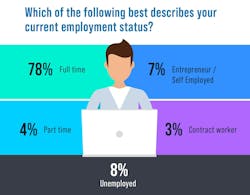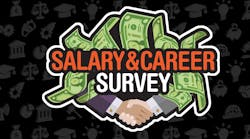Freelance Engineering 101: The Power, Job Market, and Money
What you'll learn:
- Insight into freelance engineering.
- What it takes to become a freelance engineer.
- The benefits and challenges that come with freelancing.
Being an engineer in today's world is a very rewarding career experience, providing a number of benefits and incentives for those employed full-time for a single company. The advantages are usually in line with long-term career development, access to resources, and financial stability.
Having such a career eliminates the stress associated with constantly looking for new projects and clients, and most reputable companies allow for access to the latest tools, equipment, and software that may not be affordable anywhere else. Of course, salary is the biggest draw when working at a single company.
Our recently conducted salary and career survey paints some pretty interesting numbers when it comes to engineering trends. Those working in full-time positions have decreased when compared to last year, with 77.7% maintaining full-time employment compared to 89% in 2023. Conversely, there's been an uptick for those working part-time at 4.4%, up from 2.3% over that same year.
The fluctuations between the two are persistent if we look back several years, with full-time engineering positions ranging from 78.8% in 2021 to the 77.7% it is today. The same can be said for part-time positions, which rise and fall with the same expectancy as full-timers, ranging from 3.8% in 2021 to today’s 4.4%.
The number of self-employed and contract engineers follows the same pattern as full- and part-time employees, which ranges from 13.9% in 2021 to 10.2% in 2024. While those numbers are on the decline as 2024 comes to a close, they could go up by this same time next year as big tech companies are hiring more freelance engineers.
Numbers Game: Comparing Compensation
According to a 2023 report from the Bureau of Labor Statistics, engineers had a median annual wage of $91,420—significantly higher than the median wage for all occupations in the U.S., which came out to $48,060. That's really great news, especially for new graduates who see five- and six-figure incentives as a measure of achievement, a worthy goal to work toward, and second only to experience. You can't make those kinds of figures if you don't know what you're doing.
But what about freelancing or contract work? What kind of incentives does that kind of work provide? Are wages in the same ballpark, and how do engineers gain that type of employment?
According to a Glassdoor report on engineering salaries, freelancers can earn $87K to $153K a year and have a median income of $115K, which they factored using $66K to $115K as a base income and $20K to $38K per year as "additional pay."
Those numbers have become exceptionally large for freelance work at big tech companies, including Apple, which pays freelance engineers $183K to $293K a year. Apple currently has 6,000 open jobs, by the way, with the top slot going for a qualified materials engineer (salaried at $143K to $264K) if anyone's interested.
So, the money is there in the freelance/contract market. That’s the carrot. The next question is, how do you become a freelance engineer? That's the stick. Becoming a successful freelance engineer is a challenging endeavor and typically relies on several skills—technical know-how and experience, business skills, and client engagement. But before delving into how to become one, it's important to know the intricacies of freelance engineering.
Who are Freelance Engineers?
Freelance engineers work for themselves. Unlike traditional engineering jobs, freelancers have the opportunity to contract work with any company they choose. These are typically project-based, meaning once the project is completed, so is the contract. Some clients will contract for multiple projects depending on the workload or what specializations the engineer can offer.
Knowledge is the single most valuable tool in the engineering toolbox. In the freelance market, you're nothing without it. Where were you employed, how long were you there, what projects did you work on, do you have any specialties? Many engineers specialize in a single area, and fewer are versed in multiple, so it's important to know what you're bringing to the table and what companies are looking for.
Many freelance engineers begin their careers working for a single company, becoming familiar with how the company works and gaining valuable knowledge as they go. A degree will get you so far; learning everything you can while on the job will give you the gas to go further.
Freelancers are typically specialists within their field. The more knowledge you have, the more attractive you'll be to recruiters and companies.
Freelancing doesn't necessarily mean quitting the company job either. Some engineers will maintain a full-time job while doing side gigs during their off hours, especially if they don't have the financial bandwidth to freelance full-time. It's also important to know if the company lets engineers work for others during their downtime. If they don't, it could be cause for termination.
It should also be noted that some states require being licensed when offering engineering services for public and government projects. Therefore, getting up to speed on state laws is ideal before contracting.
Steps to Becoming a Freelancer
Freelance engineering works by identifying clients and catering to specific needs and requirements. Identifying needs and proposing solutions is key in that market. Projects can come from anywhere—online job sites, headhunters, the companies themselves, referrals, and word-of-mouth. The latter might seem strange, but networking with other engineers can be worth its weight in gold. Engineering forums such as Upwork and the NSPE can be great sources, especially in group forums where networking is allowed.
Upon gaining a client, a contract is created that outlines the details of the work, with most covering project goals, timelines, deliverables, and payment terms. Clear communication during this process is critical to avoid any and all misunderstandings.
Freelancers then execute the work using their skills and tools to complete the project, which often entails collaboration with the client or their employees. They may also supply the engineer with additional tools or software depending on the project's complexity. Communication at this level is vital, too, and could help streamline the project lifecycle.
Depending on the project, work can entail the completion of certain phases. Once engineers complete those phases, they should ask the client for feedback if it isn't given and make any necessary adjustments if needed. This can also include testing or verification of the project before moving on to the next phase.
After the project is completed, engineers will often submit an invoice to the client based on the agreed-upon terms, which is ideal as most freelancers are responsible for their own taxes and financial records. And successful projects can lead to repeat business or even referrals to other companies, as a strong reputation and project portfolio are critical for long-term success.
It should be noted that gaining work experience before becoming a freelance engineer is best, as most companies prefer engineers with proven experience. They should also be regularly updated on the latest trends, software, and tools relevant to their engineering field. The freelance market is competitive, so staying updated can help to gain clients.
Benefits and Challenges of Freelancing
There are many benefits to being a freelancer. It provides a certain flexibility in choosing projects and setting schedules. It can also offer opportunities to work with a variety of industries and technologies and has the potential to bring higher income over traditional employment.
Freelancers are their own bosses, so to speak—nobody is telling them what to do and how to accomplish tasks or goals. There's flexibility in work hours and locations, the ability to choose projects, diverse experiences across industries, and greater control over career paths. Then there's the money.
The potential to make more money over traditional engineering jobs is enticing and certainly a major factor in becoming a freelancer. One of the most well-known freelancers, Jim Keller, is a testament to that notion. He began his career as an electrical engineer working for the now-defunct Digital Equipment Corporation, designing processors in the 1980s and 90s. He then moved over to AMD, building a number of their popular CPU architectures, including the Athlon K8, Zen and K12.
His career brought him to work for Tesla as VP of Autopilot Hardware Engineering, Intel as Senior VP, and Tenstorrent as CTO. He recently founded Atomic Semi, a foundry tools company that designs and manufactures low-cost, small-scale fabrication equipment. Keller's net worth isn't publicly known, but it's estimated to be in the multi-million dollar range.
On the other hand, freelance engineers can find themselves with irregular income or, worse, no employment. Work in this profession isn’t guaranteed, nor are the perks that come with traditional engineering jobs, such as insurance or a 401K. Freelancing also requires engineers to constantly market themselves to gain clients, and building a solid reputation can take years to achieve.
The process of gaining contract employment is typically faster than traditional engineering work. Some would argue that freelancing provides a unique air of freedom when it comes to accomplishing project goals. However, clients usually want perfection and far more out of freelance engineers than traditional counterparts, and project completion times are often short. Team integration can be a challenge as well, especially with career engineers who may be reluctant to work with outsiders and temps.
While there's not much information on the number of freelance engineers in the U.S. workforce, a report from the National Society of Professional Engineers (NSPE) estimates 2 million engineers populate the U.S. workforce, and that number is expected to grow. The engineering service market is also expected to climb, reaching $1.5 trillion by 2027. That said, the median wage for engineers (based on the Bureau of Labor Statistics) sits at $91,420, so there’s potential for freelancers to earn more, but they should be prepared for that competitive market.
About the Author
Cabe Atwell
Technology Editor, Electronic Design
Cabe is a Technology Editor for Electronic Design.
Engineer, Machinist, Maker, Writer. A graduate Electrical Engineer actively plying his expertise in the industry and at his company, Gunhead. When not designing/building, he creates a steady torrent of projects and content in the media world. Many of his projects and articles are online at element14 & SolidSmack, industry-focused work at EETimes & EDN, and offbeat articles at Make Magazine. Currently, you can find him hosting webinars and contributing to Electronic Design and Machine Design.
Cabe is an electrical engineer, design consultant and author with 25 years’ experience. His most recent book is “Essential 555 IC: Design, Configure, and Create Clever Circuits”
Cabe writes the Engineering on Friday blog on Electronic Design.



